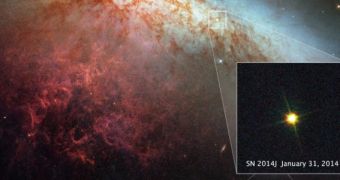Officials at NASA have just released this beautiful new image collected by the NASA/ESA Hubble Space Telescope, centered around the galaxy Messier 82 (M82). This formation is the home of the closest type Ia supernova in recent decades, dubbed SN 2014J. The recent observations are part of a much larger, international campaign to keep this event under close scrutiny.
SN 2014J lies around 11.5 million light-years away from Earth and is the strongest event of its type since a space blast that occurred in 1987, designated SN 1987A. Type Ia supernova are thought to be triggered by the explosion of a white dwarf star in a binary system. Theory holds that these objects are accompanied by another white dwarf, a Sun-like star, or a massive star.
The latest event was discovered with telescopes on the ground on January 21, 2014. Just 10 days later, on January 31, Hubble collected the image above, setting the blast in context, and revealing how the supernova looked just before it reached peak brightness. Studying how these objects light up is an easy way to verify calculations on distance in space.
Due to its sensitivity to ultraviolet wavelengths, Hubble makes for the perfect tool to monitor supernova events over prolonged periods of time. Astronomers hope that this telescope will be able to reveal the nature of both stars in the former SN 2014J binary system.

 14 DAY TRIAL //
14 DAY TRIAL //